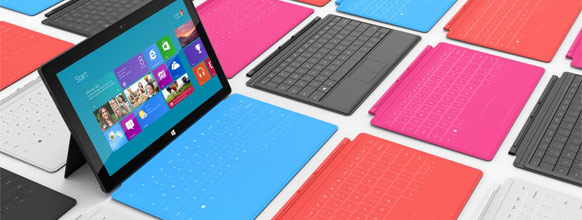Microsoft has unveiled two of its own tablet devices, in an attempt to compete with rivals Apple and Google as well as its own OEM partners. The Surface devices come in two flavours: one running an ARM processor featuring the Windows RT operating system, and one with a third-generation Intel Core processor running on Windows 8 Pro.
June 19, 2012

Microsoft has unveiled two of its own tablet devices, in an attempt to compete with rivals Apple and Google as well as its own OEM partners. The Surface devices come in two flavours: one running an ARM processor featuring the Windows RT operating system, and one with a third-generation Intel Core processor running on Windows 8 Pro.
Both devices have a 10.6in HD display and come with a cover that has a touch type keyboard and trackpad integrated into it, and also comes with a stylus pen.
The Windows RT tablet is available with either 32GB or 64GB disk space, weighs 676g and is 9.3mm thick. The Windows 8 Pro device is available with either 64GB or 128GB disk space, weighs 903g and is 13.5mm thick.
Microsoft said that the Surface tablets have been designed to “seamlessly transition between consumption and creation, without compromise”. However, Jan Dawson, chief telecoms analyst at Ovum didn’t believe Microsoft’s new offering lives up to the hype surrounding it
“There are no surprises in the software – the Surface tablet uses the same two desktop and RT versions of Windows 8 we’ve been hearing about. As such, nothing has changed there and it still looks like a huge break with the past on the surface but with a jarring switch back to the old desktop world hidden beneath,” he said.
He added that, in theory, the devices do deliver all of the benefits of both the tablet-optimised environment and the classic desktop approach and apps, but in reality the versions available to try at the moment are a “horrible mishmash of the two worlds” that is likely to be confusing for the consumer.
Dawson added that the company’s OEM partners are likely to be angered at Microsoft’s attempts to muscle in on their space.
“On the hardware front, what does it say about the tablets Microsoft is seeing from its OEM partners as it gets ready to launch Windows 8, that they felt they needed to launch their own tablet? Either they are not happy with the devices out there, or they are not satisfied with only taking a licence fee from selling Windows based tablets.
“Either way, it is a huge vote of no confidence in its OEM partners, who should rightly feel slighted. It is rarely a good idea for an OS owner to start competing with its OEM partners, and this does not feel like an exception.
However, David McQueen, principal analyst at Informa Telecoms and Media, disputed whether Microsoft’s OEM partners would be put off by the launch of the device, and pointed out that Google recently did a similar thing when it launched its own Nexus smartphone.
“That didn’t really harm the Android ecosystem, it was more of a proof-of-concept device – it showed OEMs what you could do with it,” he said. “That could be what Microsoft is doing here – showing on its own hardware how to make Surface work so that it gets picked up and people like it, and then OEMs can see how to make the most out of what it can offer.”
McQueen argued that the tablet will benefit from Microsoft’s strong app offering and expandable memory, but did concede that there does not appear to be enough differentiation between the Surface device and tablet market leader Apple’s iPad to entice users.
He said that although the touch-keyboard and trackpad cover was a good idea, the stylus pen would not appeal to many consumers, as people do not want to carry around additional accessories, and added that pricing would be key. Microsoft has suggested that the ARM-based tablet will be priced around the same price as competing tablet products, whereas the Intel-based devices will be priced around the same as the chipmaker’s Ultrabook range.
Ovum’s Dawson concluded that the device itself looks compelling, but rued the fact that Microsoft did not go into specifyics about pricing.
“Whether it sees much consumer interest will depend entirely on price and whether Microsoft is able to fix the poor UI experience in Windows 8 and RT.”
About the Author(s)
You May Also Like








.png?width=300&auto=webp&quality=80&disable=upscale)


_1.jpg?width=300&auto=webp&quality=80&disable=upscale)


.png?width=800&auto=webp&quality=80&disable=upscale)